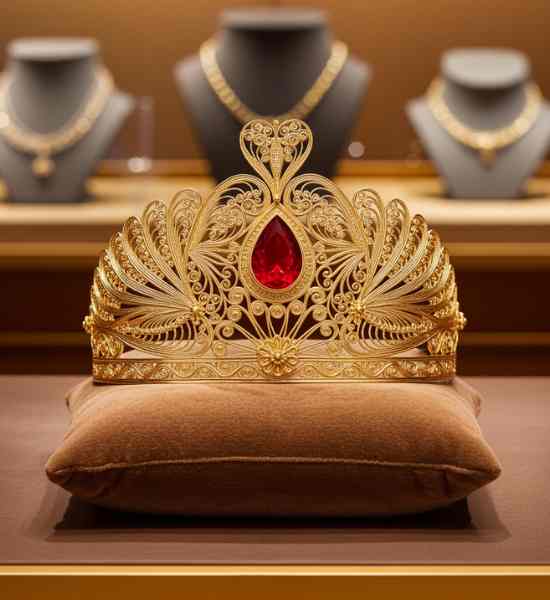Every bride dreams of a touch of royalty on her wedding day. A bridal tiara (hair crown) does just that — adding sparkle, elegance, and a crowning moment to her ensemble. In this post, we’ll explore how hair tiaras are made, their colors and sizes, their rich history (from Ancient Egypt to the Ottoman Empire), and even the influence of Disney princess crowns — all tied back to a stunning example: the gold-plated silver bridal tiara from JustScalp.
Materials & Construction of Hair Tiaras
A bridal tiara is often more than just decorative — it’s a delicate piece of wearable jewelry. Here are the most common materials and construction techniques:
Common Materials
- Base metal / core: Usually brass, copper, sterling silver, or a base alloy. These act as the underlying structure.
- Plating / finish: Gold plating, rhodium / silver plating, rose-gold plating, or antiqued finishes to give color and luster.
- Gemstones and crystals: Swarovski crystals, cubic zirconia, glass crystals, cubic zircon, rhinestones, faux pearls, semi-precious stones (e.g., topaz, amethyst).
- Pearls and seed pearls: Often freshwater pearls, glass pearls, or cultured pearls.
- Filigree / wirework: Fine metal filigree, twisted wire, or wire wrapping adds delicate flourish.
- Enamel or resin accents: Occasionally used for colored detail.
- Backing and pin loops: Small loops or combs/pins to anchor the tiara to hair.
Higher quality tiaras use better core metals (sterling silver, solid gold) and more durable plating to prevent tarnishing or flaking.
Colors & Finishes
Tiaras come in a variety of color schemes and surface treatments, often chosen to complement the bride’s dress, jewelry, or wedding theme:
- Classic silver / rhodium / platinum tone: Cool, bright, and versatile
- Gold / gold-plated / yellow gold tone: Warm, regal, vintage appeal
- Rose gold / pink gold: Soft, romantic, trendy
- Antique / oxidized finishes: Gives a vintage or “aged” look
- Two-tone combinations: Gold and silver elements combined
- Colored stones / accents: Pastel stones, colored crystals, or enamel (e.g. blush, mint, sapphire)
Typical Dimensions & Size
While tiaras vary widely, here are rough guidelines:
- Width (span): Usually 12 to 16 cm (4.7 to 6.3 inches) — sometimes wider depending on style
- Height (center peak): Often 3 to 6 cm (1.2 to 2.4 inches) — could be taller for dramatic styles
- Depth / side height: The edges taper down to smaller heights (1–2 cm)
- Weight: Lightweight designs aim for under 50 grams to avoid discomfort; heavier styles (if using real metal & gemstones) may go to 80–120 grams, but these require secure anchoring
It’s crucial for comfort and stability that the tiara be well-balanced and include anchoring loops or combs.
Historical Use of Hair Crowns & Tiaras
The concept of crowning one’s head with ornamental bands or wreaths is ancient — a symbol of divinity, royalty, victory, and status.
Ancient Egypt
- Pharaohs and queens often wore eaegill wreaths of gold, lapis lazuli, and faience.
- The “nemes” headcloth often included a uraeus (cobra) ornament at the forehead — a symbolic crown.
- Jewelry crowns and headbands were also used in religious ceremonies and funerary contexts.
Ancient Greece & Rome
- Victorious athletes and military leaders wore laurel wreaths or olive wreath crowns.
- Jewelry wreaths made of gold leaves (oak, olive) appeared in the Hellenistic and Roman periods.
- Empresses and noblewomen sometimes wore jeweled diadems (tiara-like crowns).
Medieval Europe & Renaissance
- Tiaras evolved from circlets and coronets. Royalty wore crowns; nobles might wear smaller coronets or diadems.
- Bridal crowns became popular in European traditions in later centuries.
Ottoman and Islamic Traditions
- In the Ottoman court, sultanas and royal women wore elaborate sarık (turbans) and baş takıları (head ornaments), often adorned with pearls, precious stones, gold filigree, and pendants.
- Bridal headpieces (taç, gelin tacı) entered Turkish custom later, blending Western European tiara influences with Ottoman decorative styles.
- These pieces often combined gold, pearls, and gemstones, and were worn during weddings and formal occasions.
Victorian & 19th–20th Century Europe
- The Victorian era revived tiaras as bridal and court fashion pieces.
- Queen Alexandra and other royal figures popularized diamond tiaras.
- In the 20th century, tiaras were common in royal weddings and debutante balls.
Tips for Choosing & Wearing a Bridal Tiara
- Match to your jewelry and dress tones (silver, gold, rose gold) for coherence.
- Balance size vs. hairstyle — large tiaras suit upswept hair; smaller ones for delicate styles.
- Check weight and anchoring — loops, combs, and pins are essential.
- Crystals vs. pearls vs. colored stones — choose based on your overall bridal palette.
- Try under natural light — sparkle looks different indoors vs. sunlight.
- Transport & storage — keep in a padded box to prevent bending or crush damage.
Disney Princess Crowns & Influence
- Cinderella: A classic silver or platinum tiara with tall peaks and delicate filigree.
- Aurora (Sleeping Beauty): An elegant, slightly taller tiara often shown in gold or silver tones.
- Ariel: Simpler crowns with aquatic motifs (shells, waves) in silver or gold.
- Belle: More modest tiara, complementing her golden gown — often shown in gold tone or with yellow gemstones.
- Rapunzel: Floral motifs, vine-like designs, and pastel stones.
- Elsa / Anna (Frozen): Ice / snowflake motifs, cool silver or light blue crystals, angular shapes.
- Jasmine / Aladdin: Intricate arabesque designs, gold or rose gold, often with colored jewels (turquoise, emerald).
